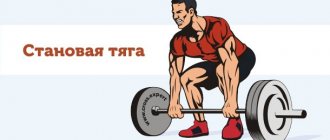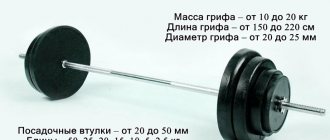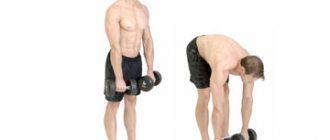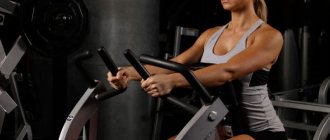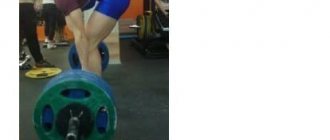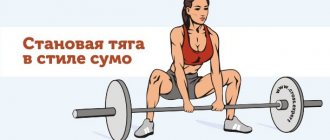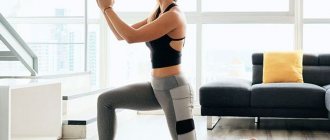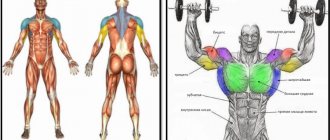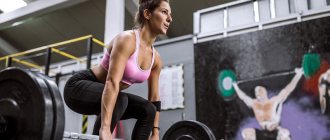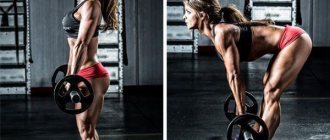The deadlift is a basic, multi-joint exercise aimed at building and strengthening muscle mass, increasing your own strength and endurance. Indeed, this exercise simultaneously engages several muscle areas: from the calf muscles to the shoulder girdle. However, if you need to focus effort on a specific muscle group, then the basic technique of the exercise must be modified in accordance with the training goals in order to correctly emphasize the emphasis. Thus, deadlift is rightfully considered a universal method of physical activity with the ability to replace individual elements of the technique with more complex ones or, conversely, simpler ones to achieve effective results in your personal training.
- Anatomical information for beginners, which muscle groups are pumped
- Advantages and benefits of back exercises
- Common mistakes when performing deadlifts, how to do this exercise correctly
- Narrow and wide grip in deadlift: what is the difference and what weight to use?
- Types of deadlifts
- Classic deadlift for men and girls
- Video instructions for the exercise:
- Deadlift (Romanian)
- Deadlift: how to perform the exercise, video tutorial
- Sumo style deadlift (lifter)
- Video instruction on Sumo deadlift
- What muscle groups are pumped by the trap bar deadlift, photo
- Video tutorial for developing the perfect trap bar deadlift technique
Anatomical information for beginners, which muscle groups are pumped
Since the exercise implies versatility, each type of deadlift includes or excludes a certain muscle group from the work. The classic deadlift is aimed at high-quality development of the back extensor muscles, biceps femoris and gluteus maximus muscles.
All muscle groups working when performing a classic deadlift (on bent legs)
The deadlift method is a straight-legged deadlift. The exercise mainly targets the legs and buttocks. If we talk about the differences between the classic deadlift and the deadlift, we can highlight the following features characteristic of these exercises:
| Exercise options | Classic deadlift | Deadlift |
| Leg position | On bent legs | On straight legs (slight bending at the knee joint is allowed) |
| Boom position level | From the floor | From the middle of the shins |
| Target muscles | Back | Legs, buttocks |
| Load intensity | Big | Average |
For those whose backs do not allow them to lift heavy weights, there is a Sumo-style deadlift. In this exercise, the main load is taken by the hips and trapezius in the shoulder girdle.
Muscles Worked in the Sumo Barbell Deadlift
Main muscles involved
It is not without reason that the deadlift is recommended by all trainers as the main stimulator of body weight growth, along with the bench press and squats. When performing it, almost ¾ of all muscles work, mainly: back extensors, buttocks, biceps, muscles of the thighs, back, forearms and trapezius. The deadlift mentioned above also targets the hamstrings, giving them maximum stress, and the upper buttocks.
Main Muscles Worked When Deadlifting
Advantages and benefits of back exercises
Rowing a barbell with straight or bent legs uses more than 73% of the muscles of the total body musculature. This means that the exercise allows you to develop not only the target muscles (buttocks, back or legs), but also auxiliary ones (arms, shoulders, abs). For the body, such an intense load is beneficial not only physically, but also physiologically. A powerful release of testosterone in men and girls helps strengthen the endocrine system.
Thus, the following advantages of deadlift can be identified:
- Exercise heals the body, speeds up blood circulation and tones the muscles.
- Deadlift involves working safely (subject to the rules of execution) with a barbell and large weights.
- The exercise helps build and sculpt muscle mass in the legs and back.
- Rowing a barbell or dumbbell strengthens the muscle tissue that supports and protects your internal organs.
- Deadlifts help fight excess weight.
- The exercise has many options: depending on your physical abilities or health limitations, you can choose a more gentle version of the deadlift.
Deadlifts must be included in the set of compulsory exercises in both men's and women's training. Whatever your goals, be it bulking, losing weight or cutting, barbell rows with straight or bent legs are great for achieving these goals.
Common mistakes when performing deadlifts, how to do this exercise correctly
If, at first glance, the deadlift seems to you to be a simple and understandable exercise, then do not rush to grab the equipment, since the deadlift technique actually has a lot of nuances and pitfalls, knowledge and ignorance of which can fatally affect the effectiveness of training.
Common mistakes when performing deadlifts, what not to do, examples and photos:
- In the classic version, when lowering the bar, the discs should actually touch the floor. Most often, it is at the peak point that inexperienced athletes make the mistake of not lowering the bar all the way. But there is also the opposite situation, when the barbell hits the floor by inertia and at high speed. In both cases, the rules of the classic deadlift technique are grossly violated. Try to maintain the amplitude: in the classics, lower the barbell slowly, barely touching the floor, and similarly lift it to the starting position.
- When the bar is at floor level, the lift should come from the leg muscles, not from the back. If, at the first stage of the pull, you first engage your back and then the back of your hips, then you risk getting a joint injury or a lower back strain.
- The starting position in any version of the deadlift is with the barbell in your hands on straight legs. Starting an exercise with a half squat is a mistake.
- When performing classics or deadlifts with a standard or trap barbell, do not spread your legs too wide. This will prevent your arms from lowering the bar correctly and, in addition, a wide stance creates additional stress on your back.
- Lifting the barbell should not be accompanied by bending your back back. Try to keep your body straight.
- The shoulders should not rotate when performing a deadlift. Fix them in one position. In the peak phase they should be directed straight down.
- Do not use gloves to grip when deadlifting. Gloves do not guarantee a firm grip of the hands with the bar; it is better to do without them.
Errors in performing deadlift elements at the top and bottom points
Do you need insurance and seat belts?
Deadlift Safety Straps
If you are training purely for yourself and do not plan to compete, then you are unlikely to need insurance. Belts are typically used by athletes in tournaments to allow them to lift heavier weights. But for ordinary trainees, it is important to first perform the exercise without mistakes, so as not to get injured.
Deadlift harness
Unlike squats, deadlifts do not require two people to perform. In case of incorrect technique, severe pain or other force majeure situation, you can always throw the barbell, for which you do not need a spotter.
Narrow and wide grip in deadlift: what is the difference and what weight to use?
When performing deadlifts, you can use a narrow stance (shoulder-width apart) or a wide stance (wider than shoulder-width apart). The latter option requires good physical fitness, since it involves more muscles of the back (latissimus, rhomboids, trapezius) and lower back. If you are a beginner, start training with a standard narrow arm position. If you're ready to move up to a higher strength level, try placing your hands further apart. In this case, the use of special equipment and repeated training is allowed.
A wide grip subsequently affects not only strength, but also hypertrophy of the spinal muscles. In addition, this arrangement of the hands takes the load off the legs, in particular from the back of the thigh, and the muscles swing better.
In addition, it is worth noting that deadlifts can be performed with a direct, reverse or mixed grip. The most common is a direct grip, when the fingers are directed towards the athlete when working with the barbell. The mixed grip is most often used by professional athletes when using heavy weights. In this case, the fingers of one hand are directed towards you, and the fingers of the other hand are directed away from you. This grip prevents the bar from slipping out of your hands when lifting a heavily loaded barbell. A reverse grip involves turning the hands in the opposite direction, i.e., the fingers of both hands point in the opposite direction from the athlete.
lop
Types of deadlifts
Classic deadlift for men and girls
The classic deadlift technique is based on tilting the body with abduction of the pelvis and bending of the legs. To start the exercise, select an apparatus. This could be a barbell with discs, an empty bar, or a kettlebell.
- Place your feet shoulder-width apart, do a half-squat and pick up a barbell with an overhand grip.
- Pushing your feet off the floor, pull your body up, holding the equipment with straight arms.
- Starting position - standing position with a barbell at hip level.
- Begin to slowly lower the barbell toward the floor, pushing your pelvis back and bending your knees.
- Watch your breathing: tilt - inhale, starting position - exhale.
Number of approaches and repetitions: 3×15 times.
Phases of the exercise: classic deadlift with a barbell on bent legs with an ear grip
The kettlebell deadlift has a similar technique. Only in this case, the hands are positioned in a lock in front of you. Instead of a kettlebell, you can use one or two dumbbells.
Deadlift technique using a kettlebell instead of a barbell
Video instructions for the exercise:
Deadlift (Romanian)
The main difference between deadlifts and classics, as noted earlier, is the position of the legs. Deadlifts are performed with straight legs or slightly bent but fixed legs. This technique pumps up the hamstrings and gluteal muscles. As in a standard deadlift, it is important to follow the basic rules: straight back, arch in the lower back, narrow grip, narrow stance of the legs. However, the body will benefit in both cases.
Starting position and peak point in the deadlift: the exercise is performed on straight legs with a straight grip
Technique:
- Place the barbell (bar) in front of you, straighten your shoulders and exhale.
- As you inhale, lean toward the apparatus and grab it with a direct grip or a mixed grip (if you use heavy weights).
- Raise the barbell and straighten your body.
- Without bending your legs, begin to lower the barbell not to the floor, but to the middle of your shin.
- When performing tilts, move your pelvis back.
Number of approaches: 3.
Number of repetitions: 10–15.
Deadlift: how to perform the exercise, video tutorial
Sumo style deadlift (lifter)
This type of deadlift is called "Sumo" due to the similar position of the legs as that of sumo athletes. The main advantages of “Sumo” over the classics are as follows:
- more stable position, since the body is positioned strictly vertically;
- the bar is closer to the body and does not cause discomfort when moving;
- the range of extension of the knee joint increases.
Technique for performing sumo deadlifts with wide stance
Exercise technique:
- Select a work implement and adjust the weight.
- Spread your feet wider than shoulder-width apart, point your toes out to the sides.
- Take the barbell with an overhand grip and straighten your back.
- Watch the position of your legs: the line of your knees and feet should coincide when performing squats and bends.
- Lower the barbell to the floor and, without pausing, return to the starting position.
Repeat the exercise 10-15 times for 3 sets.
Video instruction on Sumo deadlift
What muscle groups are pumped by the trap bar deadlift, photo
The trap bar has a diamond shape and, unlike the standard one, requires a parallel grip (when the palms are turned towards the sides of the athlete). A straight or curved bar may come forward when performing a deadlift, which is an undesirable factor in conditions of ideal technique. The trap bar eliminates such deviations and thus simplifies the deadlift. In addition, the equipment reduces the load on the lower back and knee joints.
Deadlift technique using a diamond trap bar
Technique:
- Stand in the center of the barbell with your feet shoulder-width apart.
- Do a half squat and grab a barbell.
- Take a deep breath and lift the projectile.
- Start the exercise from this position: lower the barbell to the floor, bending your legs at the knee joint.
- Then smoothly rise to the starting position.
Number of approaches and repetitions: 3×10–12.
Video tutorial for developing the perfect trap bar deadlift technique
Improper execution of deadlifts can lead to various lower back or spinal injuries, so be sure to consider the pros and cons of such a workout. Before using heavy weights, perfect the exercise technique on an empty bar or other equipment with less mass. The deadlift is a multi-joint exercise, so if you do it incorrectly, you simultaneously overload several muscle groups and joints. Control every movement: keep your back straight, bend your knees (in the classics) only at the moment when the bar approaches them, fix your shoulders in one position. When increasing the weight of the barbell, it is recommended to use protective equipment: athletic support belt, wrist straps.
Adviсe
- Be one of the first to do this exercise in your workout.
- Set a goal of 5-8 reps x 3 sets
- Always perform this exercise with an overhand grip for safety and effectiveness.
- Use wrist straps
This movement is from Dorian Yates's "eccentric" program. The eccentric (or negative) phase of the exercise is performed at a slower pace. Many athletes concentrate only on the positive phase of the exercise; meanwhile, it is just as important not to relax while inhaling. Do 1-count snatches and 2-count stretches to take your back muscle development to the next level.
